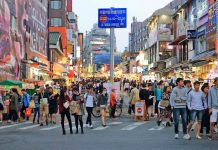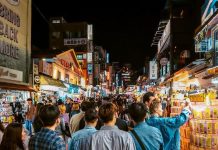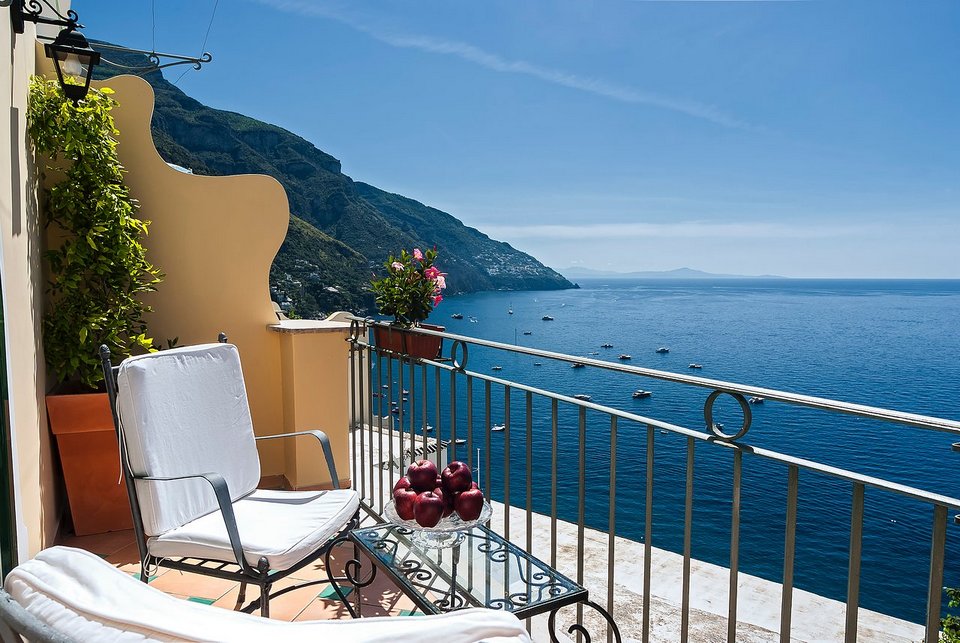Italy (or Italia in Italian) is one of the countries with the most diverse and beautiful landscapes in Europe with the greatest art treasures in the world. With mild climate, long history, rich in culture, overwhelming and magnificent architecture especially when it comes to Roman ruins, delicious cuisine which is famous all over the world. The country is known for its peaceful and beautiful rural regions, fine wines and long history. The vineyards of Tuscany, the history of Florence, the ancient streets of Rome, the poetic canals of Venice, etc. All make visitors irresistible. So, what to do and how to plan a perfect budget trip to Italy for the first-time? Let’s check out our Italy travel blog (Italy blog) with the fullest Italy travel guide (Italy guide, Italy tourist guide, Italy visitor guide) from how to get there, best time to come, where to stay, best places to visit and top things to do as well as suggested some Italy itineraries to find out the answer!
- Tuscany travel blog — The fullest Tuscany travel guide for first-timers
- What to buy in Italy? — 19+ top souvenirs & best things to buy in Italy
- Sardinia travel blog — The fullest Sardinia travel guide for first-timers
- Taiwan itinerary 6 days — The itinerary of a trip to Taipei – Hualien – Kaohsiung for 6 days 5 nights
- Alberobello travel blog — The fullest Alberobello guide for first-timers


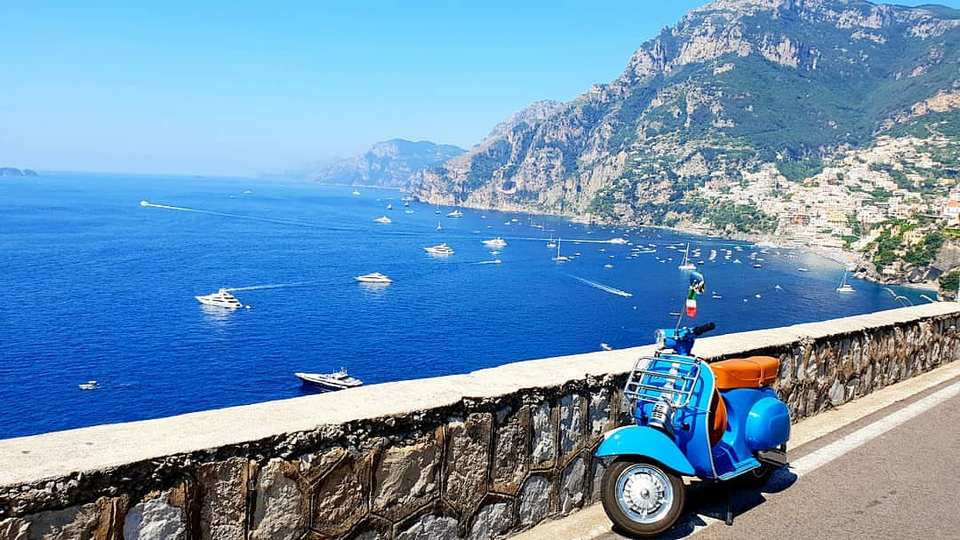
From ancient times, Italy was home to preeminent cultures like Etruscan and Roman. In the process of development, this place is also the beginning of the Renaissance period, which contributed great values for human history. The Italian capital Rome was once the epicenter of Western Civilization and the center of the Roman Catholic. In addition, Italy is also the place to set the first steps for Western culture with many UNESCO-recognized heritage sites.

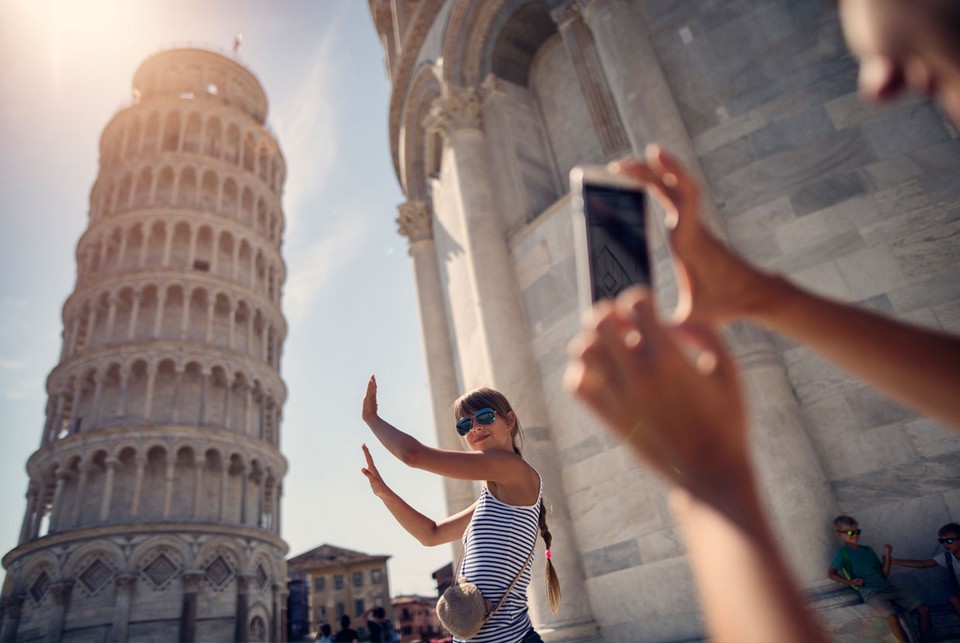
Italy travel blog: Overview of Italy

Italy, whose full name is the Italian Republic (Italian: Repubblica Italiana), is the fourth most populous country and is located in the south of Europe. Along with Greece, Italy is known as the cradle of Western civilization, with many UNESCO world heritage sites. With an area of more than 300,000 square kilometers and a population of more than 60 million people and located in the heart of the Mediterranean Region, Italy shares borders with many countries such as France, Switzerland, Austria, Slovenia, San Marino and also owns the two largest islands in the Mediterranean Sea: Sicily and Sardinia.
Where is Italy?

Italy is largely a peninsula located in the Mediterranean Sea, bordered by France, Switzerland (separated by the famous Alps), Austria and Slovenia, and the South by the Mediterranean Sea. Because Italy has the shape of a boot, it is often called by the name “boot-shaped country”.It also has many beautiful beaches, spectacular coastlines and breathtaking lakes on mountains, so it is one of the most beautiful countries in the world. In addition, not only is ranked as the 5th most visited countries around the globe, but Italy is really a powerful power in both spheres of economic and political.

It is because of such a strategic location that Italy has been the center of the Roman empire in the past. However, it is this position that brings some troubles to Italy in particular and Europe in general. Because this is the gateway for some people to illegally enter Europe (and in Italy you will come across a lot of scammers, pickpockets and illegal peddlers, which are mainly undocumented immigrants).
In addition, inside Italy also has 2 other independent countries, San Marino and Vatican (San Marino sounds strange, but Vatican is sure anyone knows).


Language & religion

Italian of course. Coming to Italy, you will have the opportunity to be captivated in the language known as “the language of love”. The most common Italian word with people around the world is “ciao”, which means “hello”.
Italian is the national language, but people here can also speak many other languages such as English, French, Latin and many others. Only when thanking or saying hello do they speak Italian. If possible, you should learn some simple Italian words, phrases or sentences to be able to communicate with locals.

Although Roman Catholicism is no longer the state religion of Italy, it is still the largest religion and plays an important role with a large number of followers. In addition, there are many other religions in Italy such as Buddhism, Sikhism, and Hinduism.

Currency
Italy is one of the members of the European Union. So, in Italy circulate and use the Euro as the official currency. Before going to Italy, visitors should exchange money in advance and bring cash with low denominations or coins for convenience to pay. At restaurants, hotels also accept international credit cards for payment.

What is Italy famous for?
TOURISM: Thanks to its beautiful natural scenery and unique architecture, rich in history and culture plus delectable cuisine, Italy has become one of the most popular tourist destinations in the world.
Each year, this country welcomes more than 95 million international visitors (ranked 5th in the world). Famous tourist destinations must be mentioned such as Rome, Venice, Florence, Cinque Terre (I will guide these destinations in the following articles).

FOOTBALL: Talking about Italy, it is impossible not to mention football. Italy has hosted the World Cup twice (in 1934 and 1990) and the Italian team has won the championship four times (in 1934, 1938, 1982, 2006).
But for me the most impressive was The 1990 FIFA World Cup. This was a forgettable World Cup for the Italian team but memorable for many people (especially tifosi or fan).
All because of the song “Un’estate italiana” (“An Italian summer”). This is one of the classic songs of the World Cup. Every time I listen to this song, the memory of a summer with top matches comes flooding back.

Some interesting facts about Italy
- In Europe there are only 3 active volcanoes today and an interesting thing is that all 3 are located in Italy.
- Vatican City is the smallest country in the world today with an area of only 0.44 square kilometers. This country is located right in the heart of the Italian capital Rome. So, if you travel to Rome, you’ve already visited 2 countries.
- San Mario is also another country located entirely within Italy. This country has an area of 61 km2 with a population of more than 21,000 people and is located in the east of Italy stretching on the slopes of Mount Titano.
- Italian is the 4th most learned language in the world, after English, Spanish and Chinese. This is also probably part of the reason why not so many Italians speak English.
- Italy is often dubbed the paradise of romance and love. Some romantic cities can be mentioned as Venice, Verona (Romeo and Juliet), Rome, Naples.
The lily is the national flower of this boot-shaped country. - Thirteen of Shakespeare’s 38 plays are set in Italy (the most famous of which is Romeo and Juliet).
- Italy is the country with the largest number of UNESCO World Heritage Sites (total of 55 World Heritage Sites)
- The main industrial center of Italy is in the North. In contrast, the South is largely agricultural, growing grapes, sugar, beets, wheat, corn, potatoes, and soybeans. So, when my sister returned from studying abroad in Italy, she joked that the South of Italy was all “peasants”.

Italy travel blog: When to go?

With a sprawling area and diverse topography, the climate in Italy is also different between the North and the South. The cold winter with snowfall from December to March is typical weather in pine forests in the North, but summer here is also quite sunny and very fresh. The lakes on mountains and tropical gardens that surround them are also the highlight of this area from April to June. Down to central Italy the weather has become wetter, with temperatures between Summer and winter are not so different. Summer is often long and the humidity here can make you feel sweltering in July and August. The further south you go, the hotter and drier the climate becomes and somewhat resembles that of North Africa. Winters are usually humid and rarely snow, which makes the peninsulas and islands to the south as ideal places to visit in the last months of year.

The best times to travel to Italy is from April to June and September, October, when the temperature is quite pleasant, and not too crowded with tourists. From July to early September is the peak tourist season with a lot of tourists. May and June are the two months when hotel prices are the highest in Rome and Florence.


Although the weather is a bit muggy in August, hotels in Rome and Florence often drop sharply. From late October to Easter, many attractions shorten their operating hours, some hotels may close for renovations, decorations, spas and beaches are mostly deserted.
Italy travel blog: Getting to Italy
The cities that tourists often choose to fly to is Rome or Milan and starting their journey from there before heading to other destinations such as Florence, Venice or Pisa… You can hunt for cheap airfares and find suitable flight routes via Google Flights, SkyScanner or Kayak. Usually, to get the best price on airfares you should book tickets from 2 to 3 months in advance.
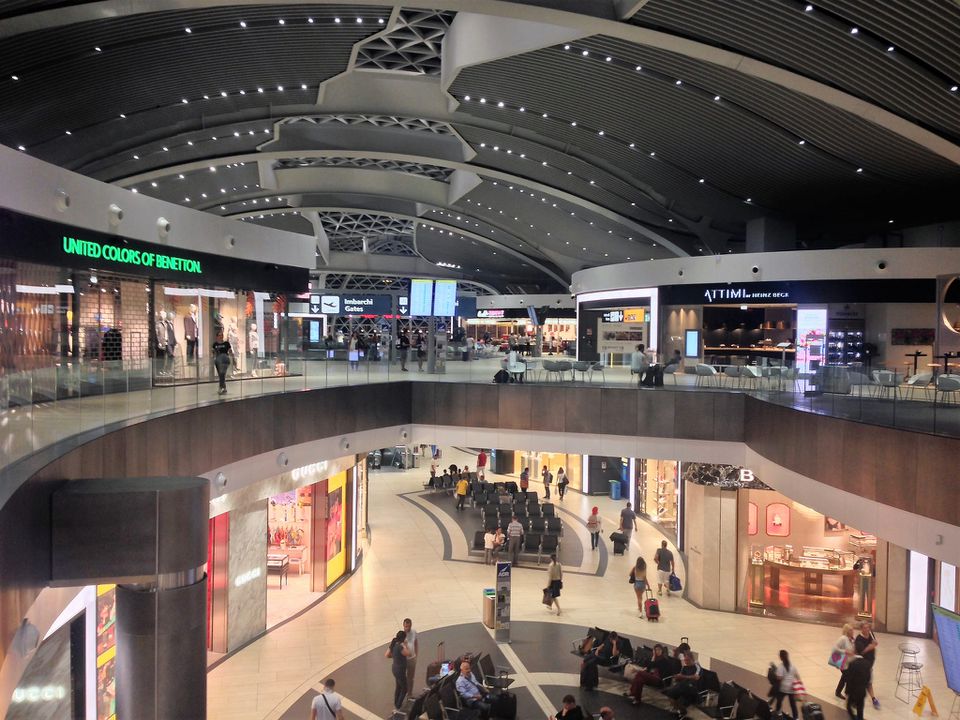
If you departing from a tourist city in Europe, you can easily get to Italy by train, bus or low-cost airlines. Italy is quite close to Switzerland, France, Austria… So, traveling between these places is also quite easy.
Italy blog: Getting around Italy
The transportation system in Italy is quite developed. The transport network stretching across the country. In general, if you want to traveling between cities, you can take a bus, train or plane, even ferry.

Metro (Subway)
Metro is widely used in Italy. It runs fast and on time and divided into several types as follows: Accelerato, locale and regionale are trains that stop at every station and run slowly. Diretto runs faster and stops at fewer stations. There are also Espresso type which runs in the main cities.

In addition, you can also take tram in big cities like Rome, Milan.. which mainly running in city center, pass through major tourist attractions.
Bus
Buses are an economical option to travel not only in European countries but also in Italy. But during our trip to Italy, we traveled mainly by train, not daring to take the bus.
The reason is that before going to, I accidentally read some of Flixbus’s frauds. Again, I heard my brothers and sisters who went to and talk about the cases of losing their belongings on the bus. So, I decided to choose to take the train, even though it is a bit expensive, but safer and more comfortable.
Train
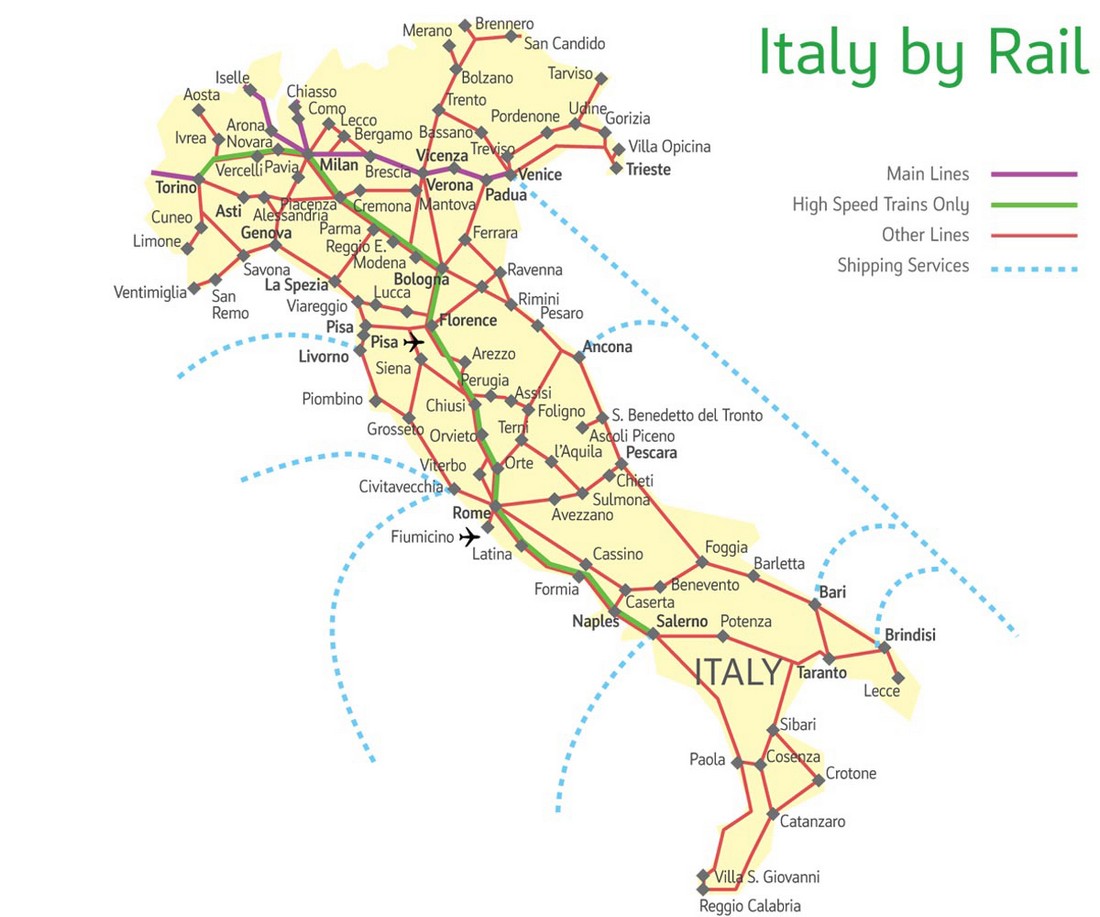
In Italy, there are two national railway companies, Trenitalia or Italo, which regularly runs to connecting cities. Trenitalia covers almost all cities and tourist places in Italy, while Italo only operate some routes. Of the two firms, I still prefer Italo because of its new train and better service.

E-tickets in Italy are widely used. You book tickets at home in advance, then just print it out and give it to the staff on the train to check (unlike in the UK, you have to go to the station to get tickets). You should subscribe to Italo’s newsletter because the company often has promotions.
Buying multiple regional tickets will save quite a bit compared to buying federal tickets. You should be careful when riding the train or traveling in public areas, need to beware of theft and fraud. You can check schedules and ticket prices on the website: https://www.trenitalia.com/en.html

Travel time between cities in Italy:
- Rome – Florence: 1 hour and 30 minutes by train
- Rome – Venice: 4-6 hours by train. Express train takes about 3 hours and 45 minutes,
- slow train takes about 6h.
- Florence – Venice: 2 hours by train
- Venice – Milan: 2 hours by train
- Florence – Pisa: 1 hour by train

Note: Regarding validate train/bus tickets: Before boarding a train or bus to go anywhere, you must validate tickets at validation machines places at stations. If staff check that the ticket you use has not been validated, it is considered a contraband and may be fined. As for the e-train tickets that are emailed to you, there is no need to validate anymore.

In addition, you can compare fares between vehicles (train, bus, plane..) at Omio website. Note because Italy is a tourist country, the price of tickets often increases when you book late or buy directly. If you have determined a detailed self-sufficient Italy travel itinerary, booking tickets online early will save more traveling costs.
We had a very detailed guide on how to traveling by train in Italy here.
Taxi
When taking taxi, you should choose white or yellow ones. More careful is that these taxis with the sign of SPQR on the front door. Because in Italy there are many vehicles operating without a license and the price is higher than a licensed taxi.
Motorcycles, bicycles and Vespas
Traveling by motorbike will give you more time freedom. However, the rental price is quite expensive. Motorcycles under 125cc are priced at 50 Euros/day. For bicycles it is 7.5 Euros/day. If you want to travel in style and beauty, you can also rent a Vespa but the price is a bit high.

Ferries, ships, boats
Some destinations require visitors have to take a ferry or boat to get to, for example: Capri, Venice, Burano, Murano islands…

Italy travel blog: Where to go and what to do?
With its topographic diversity, stretching from north to south with many attractions, I think it takes a lot of time to explore all of Italy. So, I recommend where to go depends on your starting point.

Usually, if only travel to Italy for 7 days, travellers often choose to visit the capital Rome and the city of Venice. This itinerary is a bit far because you need to take the train for 4 – 6 hours to traveling between the two cities. But if you have more time, I recommend going the following way:
- If you come from France, Switzerland or Slovenia, you should visit Northern Italy. Typical are Venice, Dolomites, Milan, Lake Como, Cinque Terre.
- Pisa, Florence, Tuscanny are located in central Italy and only about 2 hours by train from Milan or Venice. You can add these destinations if you have time. Rome also belongs to the central region but is located closer to the south, so traveling from Rome to Venice takes about 4 – 6 hours.
- Below Rome will be cities to the south such as Naples, Pompei, Amalfi coast, Capri.
- Besides the cities I have listed above, around the main points like Venice, Florence and Rome, there are also many other famous small tourist cities such as Verona, Sienna, Bologna, Chianti… I think if you have only 1 or 2 weeks, you can hardly go to visit the whole country. Maybe even 1 month is not enough. So, I just listed below the most famous and most visited Italian tourist destinations for you refer to and make your own suitable itinerary.

Rome
“All roads lead to Rome”, is a familiar saying that anyone will think of when referring to Rome. Why lead to Rome and not another city. Because this city has been the cultural and political center of the world for many centuries. History has left Rome with a cultural, architectural and historical treasure that no other city in the world can match.
The whole of Rome is a living museum, where not only the monumental structures but even each stone in the ruins has its own stories.

ROME TRAVEL TIPS
- Time to visit: May, June, September
- Accommodation area: Termini station area
- Transportation: Subway, Bus and Walking
- Tourist attractions: Colosseum, Vatican City, Trevi Fountain, Spanish Steps, Pantheon Temple, Victor Emmanuel II Monument (Altar of the Fatherland), Castel Sant’Angelo
Florence
Florence is often hailed as one of the most beautiful cities in the world. It is the birthplace of the most greatest masters in the history of the world in the Renaissance Period such as Michelangelo, Donatello and Leonardo Da Vinci.

As the capital of Tuscany region and located right in the heart of Italy. The city of Florence is just 300km to the south from Milan and 280km to the north from Rome.
This famous Italian tourist city was once the capital of the Kingdom of Italy in the period of 1865-1870. Not only has a history of more than two thousand years old, it is also the home of the Renaissance in Europe in the fifteenth and sixteenth centuries.
Once the cradle of Renaissance art and culture, in Florence you can find some of humanity’s most famous works of art. The most famous of which is Michelangelo’s statue of David.
FLORENCE TRAVEL TIPS
- Time to visit: March – May or September – October
- Accommodation area: Quatiere 1
- Means of transportation: Walking
- Tourist attractions: Ponte Vecchio Bridge, Bargello Museum, Pizzale Michelangelo Square, Florence Cathedral, Galleria dell’Accademia Museum
Lago di Como (Lake Como)
Located at the foot of the Alps, Lake Como in Northern Italy is likened to a jade of Italy because of its poetic natural scenery. This was the favorite resort of the nobility and the rich, celebrities. Along both sides of the lake are magnificent mansions, castles, palaces interspersed with beautiful small villages.

LAKE COMO TRAVEL TIPS
- Time to visit: July, August
- Accommodation area: Varenna Village
- Transportation: Ferry and walking
- Tourist attractions: Bellagio, Varenna, Menagio, Villa del Balbianello, Villa Monastero, Villa d’Este, Castello di Vezio.
Venice
Venice Italy (Italian called Venezia) is known as one of the most romantic cities in the world. This beautiful city of Venice is located in the northeast of Italy, just 1m above sea level and is formed from 118 surrounding small islands with more than 160 canals connected and more than 500 bridges. The name Venice originally comes from the ancient Venetians who lived around the 10th century BC. In Latin, Venice means love.
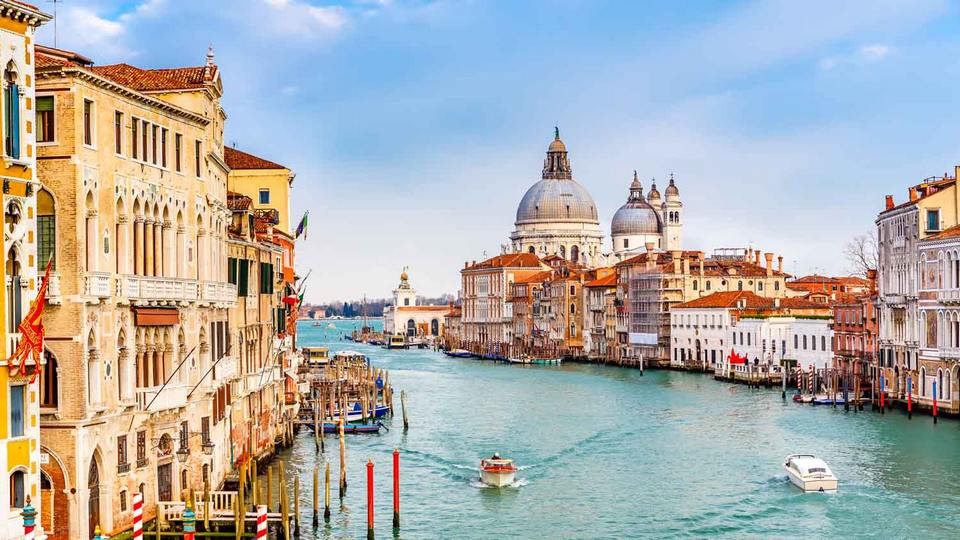
This is the only city in the world built on water, with an interlaced network of canals. Regardless of the angle of this city, it retains a romantic and poetic beauty that is hard to find anywhere else in the world. Each year this beautiful city welcomes more than 25 million tourists from all over the world.
VENICE TRAVEL TIPS
- Time to visit: May, June, September, March
- Accommodation area: Venice main island (around the Grand Canal because of its proximity to water bus stops) or the mainland suburb of Mestre
- Transportation: Water bus and walking
- Tourist attractions: San Marco Square, Rialto Bridge, Bridge of Sighs, Murano – Burano – Lido Islands, San Giorgio Maggiore, Scala Contarini del Bovolo
Milan
Milan is the second largest city in Italy (after Rome) and is located in Northern Italy. The fashion capital of Italy is the 5th largest city in Europe with more than 1.3 million inhabitants. As a cosmopolitan city, Milan has more than 13% of its population expats and is ranked in the top 15 most expensive cities in the world.
There are not many places to visit like Rome or Florence, but coming to Milan you will be lost in a world of fashion with all kinds of brands from around the world.
MILAN TRAVEL TIPS
- Time to visit: July and August
- Accommodation area: The area around the cathedral of Milan
- Means of transportation: Metro
- Tourist attractions: Milan Cathedral, Galleria Vittorio Emanuele II, San Siro Stadium, Sforzesco Castle, Pinacoteca di Brera
Dolomites
The Dolomites is a region located in the north of Italy and only about 2.5 hours by car from Venice. This land is part of the famous Alps, so the natural scenery here is also very unique, majestic and not inferior to the mountains in Switzerland.
In fact, Dolomites is probably still considered a “hidden gem” for tourists because most people only visit Venice and Rome when traveling to Italy. If you are a nature lover, I highly recommend you to come here. This region is full of majestic high mountains, turquoise lakes and lovely small villages. With the cost can be only half that of the neighboring Switzerland, coming here to explore is absolutely a must.

Personally, Dolomites deserves to be the top 5 most attractive destinations of Italy. If you want to fully explore this region, you will probably need from 4-7 days because the terrain here is quite difficult to traveling as well as trekking or hiking.
Cinque Terre
Cinque Terre is a group of 5 villages on the northern coast of Italy, known as “The most colorful place on Earth”. Each house here is painted with a different color, all mixed with the golden sun and the blue color of the ocean creating a colorful picture, a picturesque land. Cinque Terre attracts tourists not because of its magnificent nature or massive architectural works, but because of its colorful houses perched on craggy cliffs. Five lovely small villages here were also recognized by UNESCO as a world heritage site in 1997.

CINQUE TERRE TRAVEL TIPS
- Time to visit: May – September
- Accommodation area: It is not recommended to stay overnight
- Means of transportation: Train and on foot
- Tourist attractions: Vernazza, Manarola, Corniglia, Riomaggiore, Monterosso al Mare
Pisa
Pisa is considered one of the most famous tourist cities in Italy. The most prominent spot that makes the city famous is the leaning tower of Pisa. Your trip to Italy will be more complete if you can visit this architectural masterpiece.

Pisa is only about 1 hour from Florence by train, so getting here is quite easy, the port of Pisa is also a transit point to many major cities in Italy.
Naples
The city of Naples, also known as Napoli, is the most famous destination in the South of Italy with many impressive architectures, historical traditions, and delectable cuisine.
The central district of this city has been recognized as a UNESCO heritage site and officially becomes the largest historic area of Europe today. Not only that, Naples is also the home of Pizza, Gelato ice cream – dishes that contribute to bringing Italian cuisine to the world.

Beyond the center of Naples, you can also visit many famous destinations near Naples such as:
- Pompeii: An ancient town that has been around for many years BC.
- Vesuvius Volcano
- The island of Capri
- Cities along the Amalfi coast such as Positano, Sorrento…
Italy travel blog: Where to stay?
Hotels in Italy are often not as new and modern as in other European countries because most destinations are places that need to be preserved. In general, hotel prices here are also on par with other famous tourist countries in Europe such as Spain, Austria…
The average price is around €25-40 for budget hotels and a bit far from the center. In central areas in Rome or Venice, of course, the price will be much more expensive. 4-star rooms can be around €200-300 per person.

A small note is that in Italy often there is a city tax. Tourists often have to pay this extra to the city. Hotel owners will often collect it for city when guests come to stay. Up to now, Italy is the only country that applies this tax.
Sleeping in a hostel/dorm is the most economical, the price is usually around 20-30 euros/night, in some places it is from 50-70 euros/night. Private rooms cost about 50-100 euros/night for guesthouses or budget hotels. High-end or upscale hotels have a wide range of prices depending on the hotel type and location.

To find the top rated and best hotels in Italy you can go to Agoda.com, Booking.com. For a budget stay, you should consider to stay in Airbnb.
Italy blog: What to eat?
Italian cuisine is extremely diverse, rich and each region has its own signature dish. But the famous dishes that are familiar and branded to Italy are pasta, pizza and gelato (ice cream). Of course, ingredients are an essential part of making a delicious dish. In Italy, ingredients are carefully selected, partly influenced by British and French culinary cultures, combined with special and unique spices, each dish will bring you into another world of flavors.

Panini
Panini is a traditional Italian sandwich. The ingredients in the dish include: bread, filled with ham, cheese, cabbage salad, tomatoes and pesto sauce and it als has various of types such as chicken panini, beef panini, vegan panini… All the flavors blend together to create an attractive dish that is most loved and is also convenient at affordable price.

Parmigiana (Crispy Chicken Parmesan)
Many visitors come here have to fall for the taste of chicken Parmigiana. Especially in the two regions of Campania and Sicily of Italy. Delicious dish with tender chicken fillet, grilled in tomato sauce and topped with rich cheese. This delicious and beautiful dish makes anyone crave.
Risotto
Risotto rice is famous all over the world. For processing, people cook rice with a creamy broth. To make broth, people cook from bones, meat, vegetables, etc. This dish can be served with other dishes such as grilled meat, which is also very delicious.

Panna Cotta
Panna Cotta is very popular dessert in Italy. The name means “cooked cream”, which is a flavored combination of cream, sugar and vanilla. This dish is also popular around the world in its various processing ways. However, go to Italy to enjoy this authentic delicious dish.

Gelato (Italian Ice Cream)
The globally famous Italian Gelato is at number one on the list of the answers to the question “What is the best ice cream in the world?”. Not too sweet, Gelato ice cream is the perfect combination of cream, milk, and fruit… It also come in various types and flavors. This is definitely a must-have dish especially in summer in Italy.

Tiramisu cake
Surely, many of you have heard the name of this Tiramisu cake. Super delicious dessert with a very aromatic coffee-flavored. It is made of of moist and fluffy vanilla layers with a mixture of eggs, sugar, and mascarpone cheese, coffee liqueur and espresso.

Lasagna
Traditional Italian food Lasagna has a very good taste. Includes multiple stacked layers of flat pasta filled with minced meat, tomatoes, onions, vegetables and cheese. Add to that the bechamel sauce that takes the dish to a whole new level.

Tortellini
This is a very popular little Italian pasta dish, are ring-shaped pasta. Tortellini are made with unfermented dough stuffed with meat, egg and nutmeg, vegetables and cheese. Almost all main Italian dishes have cheese.

Spaghetti
The famous Spaghetti dish is so famous and very popular across the world, is a long, thin, solid, cylindrical pasta. The dish is served with minced meat, tomato sauce and some vegetables. Depending on the type, there are different flavor combinations. Bacon, eggs, anchovies or other ingredients.

Minestrone Soup
Minestrone soup is a mixed soup made with different ingredients including vegetables, often with the addition of pasta or rice, sometimes both. People here often eat this dish in the summer. It is delicious when eaten hot or cold.

Frittata
Frittata is a traditional dish. This is a nutritious omelet with vegetables and cheese. People cook on the stove first and then put it in the oven to bake. This Frittata is used by Italians as a delicious breakfast.
Pizza
Referring to Italian cuisine without mentioning Pizza seems to be too flawed. This is a famous dish not only in Italy but also in most countries around the world. The homeland of this cake as I mentioned earlier is Naples – the first seaport city of the Mediterranean region.

However, not everyone knows that before it was as famous as it is now, it was just a dish for the poor. When the people did not have rice to eat, the people thought of a way to use flour to make cakes and put the ingredients on top and then bake. That is the origin of today’s pizza.
Chocolate Ferrero Rocher
Surely this type of chocolate is no stranger to almost visitors, especially chocolate lovers. This is a premium chocolate that is sold all over the world. Most of the stores I’ve been to in Europe have this chocolate.

This is an Italian product dating from 1982 to represent gold – a symbol of luxury and high class. If you are still wondering what to buy as a gift in Italy, consider this chocolate.
In addition, drinks such as coffee, Italian wine are also worldwide famous. If you enjoy the taste of espresso, latte or cappuccino, you will definitely never forget it, especially right in its home.

Types of restaurants in Italy
When looking for information about Italian tourism, I didn’t know why the same restaurant, some place called ‘ristorante’ and the other called ‘trattoria’. In fact, these are different types of restaurants. So, what types of restaurants in Italy?
In Italy there are 5 popular types of restaurants: ristorante, trattoria, osteria, tavola calda and pizzeria.
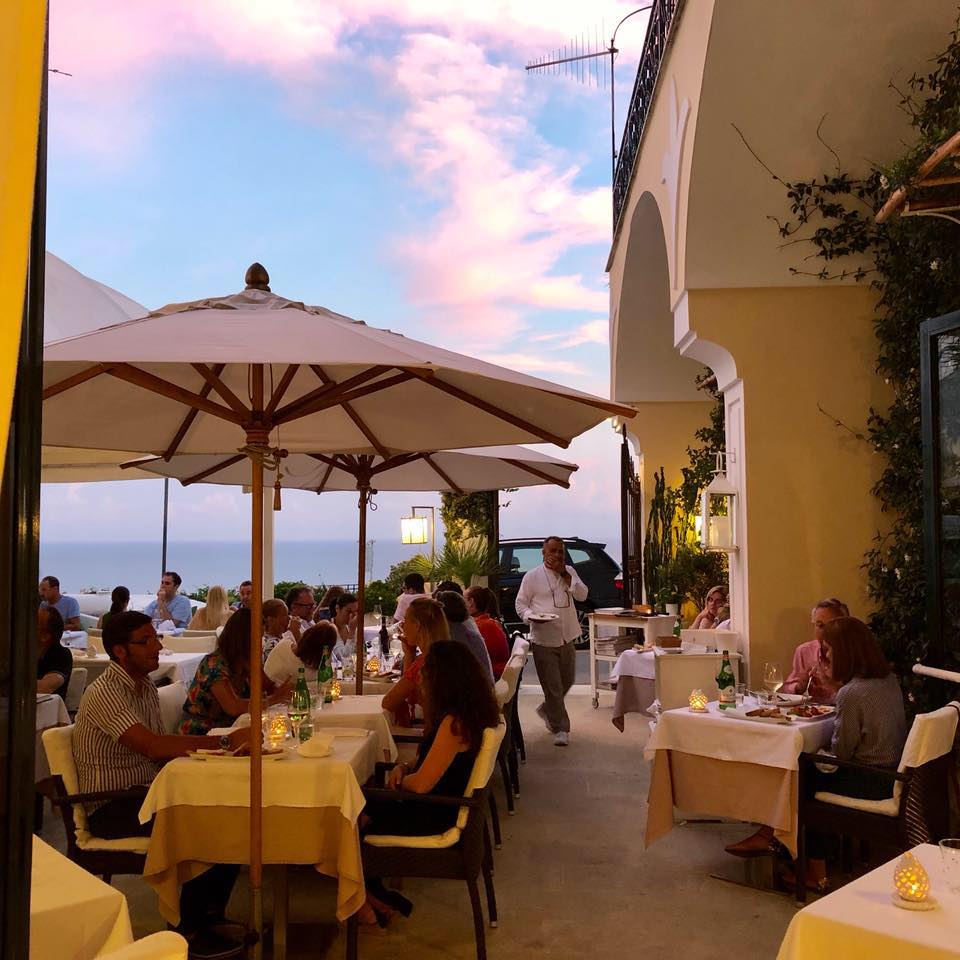
- RISTORANTE: It’s a “true” restaurant, with space, fully set up and serving dishes from appetizers to desserts. Ristorante is usually easy to find because it is right on the main streets, but the price is not cheap at all.
- TRATTORIA: Usually a family restaurant (for fun, the restaurant is owned by old people). Unlike ristorante, trattoria are often located in small streets. This restaurant serves mainly homemade food with fresh food purchased on the day.
- OSTERIA: Osteria is somewhat similar to trattoria, but smaller in size and serves local dishes.
- TAVOLA CALDA: Tavola calda means “hot table” in English, but it doesn’t have to serve hot food. But this is similar to casual eateries, you will select your meal from ready-made food trays.
- PIZZERIA: The restaurant only specializes in serving pizza with some side dishes such as salad, pasta and wine.

Tips
- You should eat at Trattoria because this is the favorite place of the locals, and the taste of the food is also very Italian.
- When dining at a ristorante, you will have to pay extra service fees, table fees, etc. And sometimes the fees are as expensive as the meal itself.
Italy travel blog: What to buy?
What should I buy when traveling to Italy? This will be a difficult question for many people, but for fashionistas, it is definitely buying clothes. Italy is a shopping paradise with many famous brands in the world.
Some suggestions if you still don’t know what to buy as a gift:
- Brands, clothes, jewelry: Italy is famous for fashion, so you can easily buy these items anywhere. The most prominent is probably one of the world’s fashion capitals: Milan.
- Glassware: Venice has a village specializing in the production of glass and glassware famous around the world. This is where the stained glass is produced, which is used to assemble glass doors in world-famous buildings such as the Sagradia Famalia of Barcelona, Spain.
- Souvenirs: Mask-shaped magnets in Venice, tower-shaped magnets of Pisa… with average price is €1-3/piece. In addition, there are also many other souvenirs bearing the characteristics of each Italian tourist destination such as masks, miniature models of the leaning tower of Pisa, Pathenon temple, T-shirts or bags printed with famous works, leather goods in Florence…
- Chocolate Ferrero Rocher

NOTE
- With any shopping bill over €154.95, you will receive a maximum tax refund of 22% depending on each item.
- There are still some immigrants selling fake brands.
Italy blog: Suggested some Italy travel itinerary
Itinerary for 3 days
If you only have 3 days in Italy, I think you just need visit Rome. Personally, I think 3 days is quite short for Rome. See details of itinerary here.
Itinerary for 5-7 days
Usually besides Rome, people will choose to go to Venice or Florence. I think Venice is not as prominent as many people praise, maybe if I have an opportunity to choose again, I would go to Florence or Naples because they closer.
In general, 7 days is not really enough compared to the number of tourist destinations in Italy. You can choose a destination depending on personal preferences such as Venice, Florence, or the southern region with cities like Naples, Pompeii, Positano.
Itinerary for 10-14 days:
Day 1-4: Rome
Day 5-7: Florence
Day 8-11: Venice
Day 12-15: Milan – Lake Como or Dolomites.
Itinerary for 8 days 7 nights
According to my self-sufficient travel experience in Italy, you should spend 5 days or more to feel the unique features of this land. Usually for convenience, visitors often go to places close to each other in Northern Italy, Central Italy or Southern Italy.
But because it was my first time traveling to Italy, I chose famous tourist destinations such as Milan, Rome, Venice, not limited to one region at all.
In addition, we have visited 2 new destinations in Italy: Cinque Terre and Lake Como. Here is my suggested 8D7N Italy travel itinerary (note that this itinerary will be for reference only):
Day 1: Milan
Day 2: Milan – Cinque Terre – Milan
Day 3: Milan – Lago di Como – Milan
Day 4: Milan – Venice
Day 5: Venice
Day 6: Venice – Rome
Day 7: Rome
Day 8: Rome

Italy travel blog: How much does it cost to travel to Italy?
According to my experience, in general, the most expensive cost is to rent a room and eating (Renting a room costs an additional accommodation fee, dining at a restaurant costs a table fee).
I depart from the UK so I can save a bit of airfare. If you fly from other cities, it will cost you more. If the cost of air tickets and visas is not included, the daily budget can be:
- 50-70 euros/day: for travelers who go on a budget, sleep in a hostel, eat economically, can cook for yourself, take public transport, visit a few spots.
- 100 euros/day: can stay in guesthouses or budget hotels, eat better, visit more, can buy some tours.
- 200 euros/day: better hotel stay, dining, sightseeing and better services.
You can refer the traveling cost for 8 days 7 nights in Italy as follows:
- Transportation: Airfares (€120,42) / Train tickets (€97,06) / Traveling in cities (€50,8)
- Stay: 7 nights €235,06
- Trip costs: Admissions (€113) / Eating (€219,7) / Shopping (€32)
Total: €868,04

Italy travel blog: Notes to know before you go
- In big cities not only in Italy but also in Europe in general, it is very common with pickpocketing, theft or scam. You should careful. It happens more often in Rome than in Venice and Florence but you still must be pay attention. If going out, it is best to go in a group. Moreover, you need to limit as much as possible communication with strangers or walking alone in crowded places.
- Italians is one of the worst English-speaking peoples in the world. Therefore, before you go, you should learn a few basic communication sentences, phrases or words in advance and communication in body language is encouraged here. It is not difficult to see Italians when talking, always using body language in the street.
- At some tourist attractions, eating or drinking is not allow. For example, if you are caught when eating and drinking at a tourist destination such as Fontana di Trevi or Plaza Espana, you will be fined €50.
- Regarding renting a self-driving car if you have a need, you should note that roads in Italy are small, bumpy and have many mountain roads. If your steering wheel is steady, then take the wheel.
- One important thing you need to remember is not wear too short when entering churchs. Many places like Vatican require visitors wear long, non-revealing clothes.
- With famous tourist spots, you should come early around 8am – 9am to visit because after 10am, the number of visitors is very crowded. I remember the time I went to Venice in the morning, it was still quite empty at 8am, but at 11am, the alleys were full of tourists. Or like in Florence, the queue to visit is terribly crowded, maybe you will have to wait 3 or 4 hours to get your turn. So, to avoid wasting time for queuing, you should buy tickets in advance.
- Tips for waiters and waitresses in restaurants in Italy are optional. It is not like in the US or other countries with a tip culture. Although tips are not required, but you will have to pay a fee to sit at the restaurant. In Italian it is called coperto or cover charge. Fees range from 1-5 EUR/person. Both tourists and Italians are charged. So, Do not tip the service staff at the restaurant because they have already charged sitting tax and service tax in the bill.
- In Italy cash is extremely popular. Therefore, it is difficult for visitors to pay by card if entering grocery stores or small restaurants. You should bring cash enough for convenience.
- Italians do not have the habit of drinking coffee with milk after a meal because it is not good for health. If you drink cappuccino in the morning, it will be better.
In addition, do not feel strange if you are missed an appointment. Because Italians love “rubber” hours. Even administrative offices or shops work later than the prescribed hours. - Italians have a taboo that is asking for cheese when eating seafood noodles. In culinary culture of this country they do not eat cheese with seafood. So it will be very “unpretentious” and if you do not want to be noticed, you should not eat like that here. Also, do not eat Spaghetti that is cut into small pieces.
- In some tourist destinations (such as the road section to the Vatican or in front of the Milan cathedral) there is still a group of people, enticing tourists to buy tours along the way. The police know this and they stand right there, but they don’t do anything. I cannot understand why.
- And don’t forget to prepare a power adapter because cities in Southern Italy still use 3-pin power sockets (2-pin sockets can still be plugged in, but it depends on the device).

Some best day tours, trips, activities and transfer services, tickets in and from Rome you can refer to
- Private Fiumicino Airport (FCO) Transfers for Downtown Rome
- Shared Fiumicino Airport Transfers (FCO) for Rome by Terravision
- Colosseum, Roman Forum and Palatine Hill Tour
- [Buy 1 Get 1] Rome Big Bus Hop-On Hop-Off Tours (Open-Top)
- Rome to Florence Day Tour
- Colosseum, Roman Forum and Palatine Hill Skip-the-Line Entrance Ticket in Rome
- 1 Roma Pass for 45+ Attractions
- OMNIA Vatican and Rome Card
- Vatican & Rome Combo Sightseeing Tour
- Venice Excursion Day Trip
- Day Trip to the Ruins of Pompeii
- Positano and Amalfi Coast Day Tour
- I Love Rome Hop On Hop Off Panoramic Bus Tour
- Rome Hop-On Hop-Off City Sightseeing Bus Tour

Are you looking for more Italy travel guide: Tours, activities, attractions and other things? Let’s check it out here. And travel guide for Florence, Venice, Milan, Positano, Cinque Terre, Pisa.

